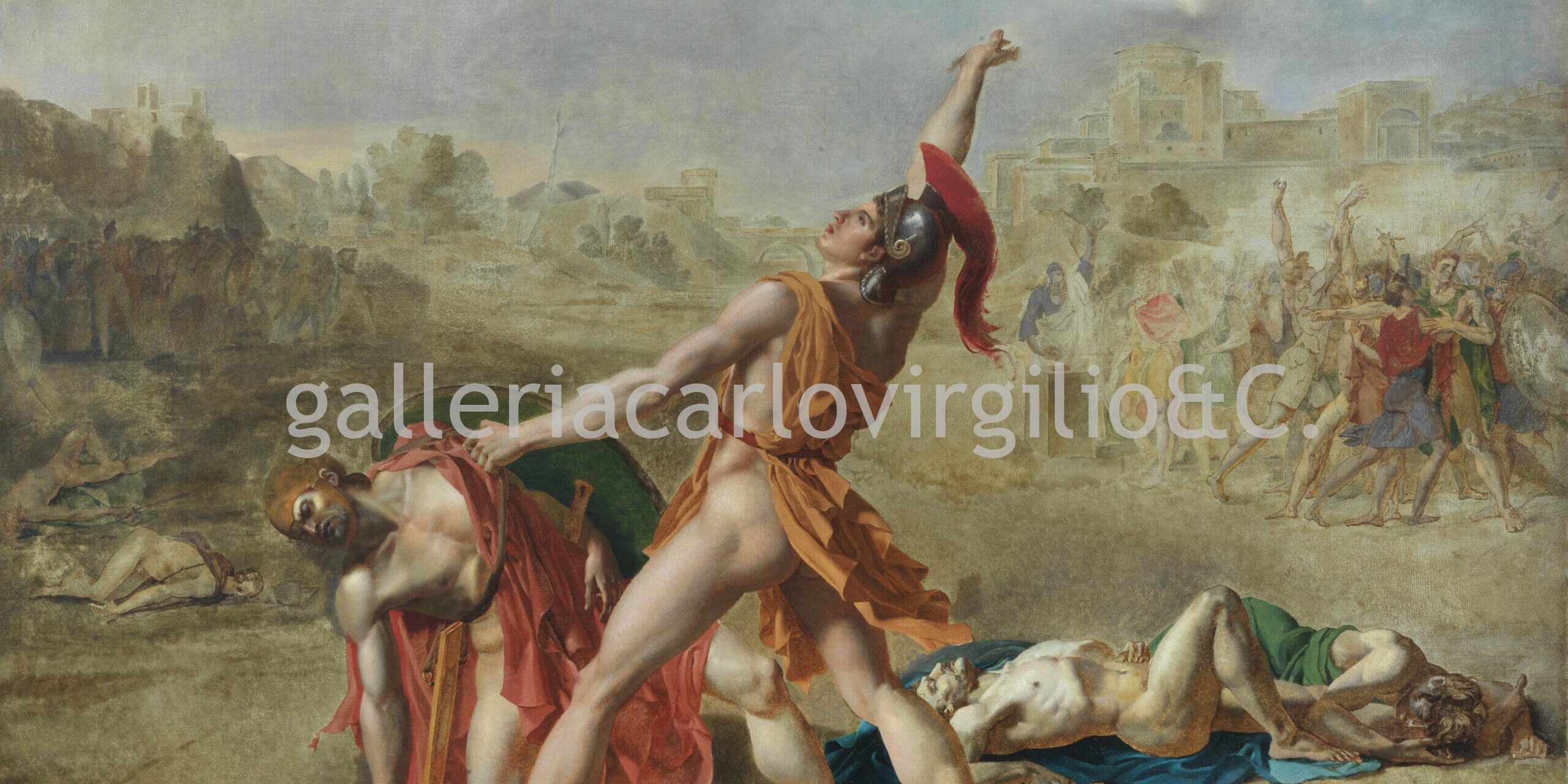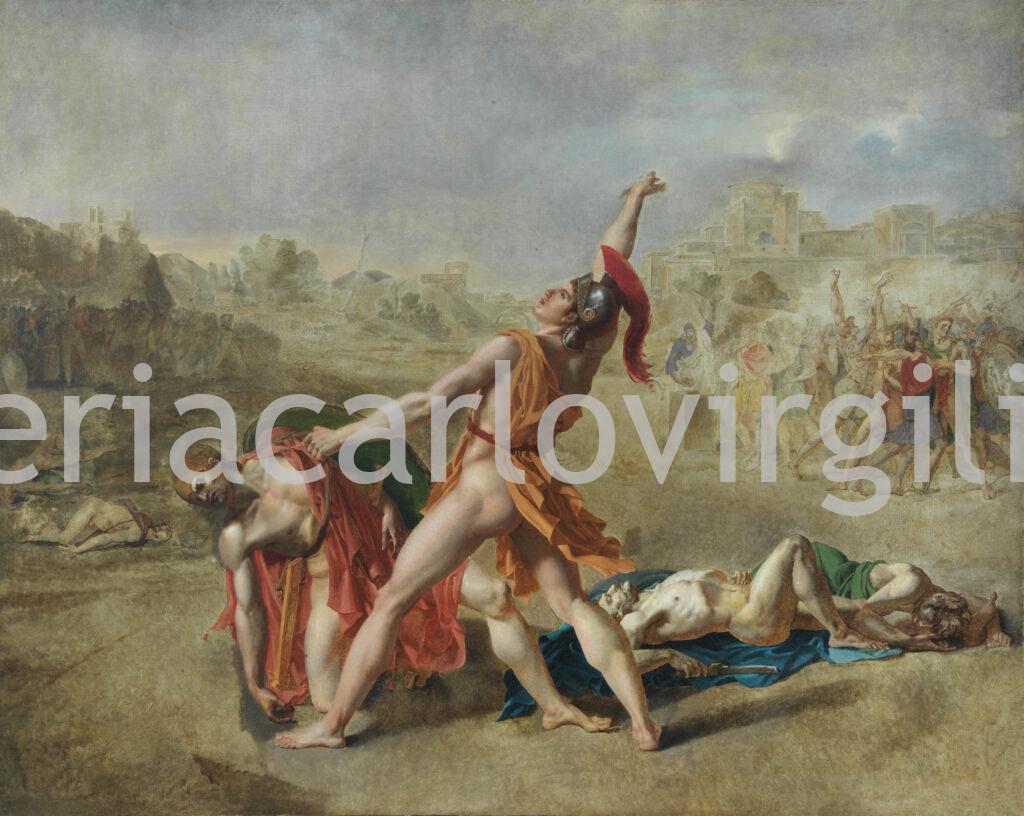| NOT AVAILABLE

French Painter of the Circle of Barbus of the School of David
Ultimo decennio XVIII secolo
The Fight Between Horatii and Curiatii • 1798-99 ca.
Oil on canvas, 127 × 159.5 cm
The painting, unfinished, is linked to the teachings of Jacques-Louis David, as reveals the figure from behind in the foreground, inspired to the central one in the famous painting The Intervention of the Sabine Women, presented at the 1799 Salon (Paris, Musée du Louvre). Also the figures in the background, rapidly sketched in pen and brush and only partially colored, appear to be consciously varied on the model of the unfinished Davidian painting of The Tennis Courth Oath (1790-94, Versailles, Musée du Chateau), in particular in the viril nude figures.
The painting is linked also with the subject of the contest for the Prix de Rome of 1798, rightly dedicated to The Fight Between Horatii and Curiatii, with a timing difference in the represented scene, as the third of the Curiatii, here showed dying, should have been still in the act of getting closer, wounded, to the battlefield. In that case, the majority of the contestants did not succeed in finishing the paintings for the contest. Only three artists could and among them the prize went to Fulchran-Jean Harriet (Paris, École nationale supérieure des Beaux-Arts)[1].
Presented for the first time to the public on the occasion of Tefaf 2024, the work is waiting further studies that could delve into the attribution problem. In the meantime, it is possible to individuate the relation with the historical subject of the Prix de Rome, an exemplum virtutis of heroical sacrifice for the homeland at the time of the European wars destined to export the French Revolution, and with David’s atelier.
At that time, in the crowded studio of the Master, a group of artists create a sort of internal opposition, willingly to stress the expressive limits of the primitivistic, archaistic and revolutionary also iconographically, classicism. They are the so-called Barbus, named after their habit to wear long beards, bohemian painters documented with few survived works but, together with John Flaxman, at the origin of the archaistic and purist current than undertaken by Jean-Auguste-Dominique Ingres and the first Lorenzo Bartolini, at the time in Paris[2]. This could be add to this important figurative field then emerged and which resulted decisive for the subsequent outcomes of the European painting, as it is so absolute for its compositional clarity and economy and strong expressiveness, both in the figures in the foreground and in the ones lying, where the saving preparation is revealed like in the studies of the Master or in the coeval by François-Xavier Fabre.
Several authoritative scholars of the French painting where asked, and they expressed, informally and friendly, their first impression. Philippe Bordes considers the work carried out in the studio of David during the execution of the Sabines or immediately after its display at the Salon. According to him, it could be by Harriet, imagining that he wanted to perfectionate the composition conceived for the Prix de Rome with the Davidian idea of the figure seen from behind and with legs apart.
The painting appears related also with The Death of Brutus by Pierre Narcisse Guérin (Vizille, Musée de la Revolution Française) which is from 1793 and presents a similar figure seen from behind in the foreground, in this case inspired by that in counterpart in The Oath of the Horatii by David (1784, Paris, Musée du Louvre). However, according to Mehdi Corchane, scholar of Guérin, the works appears more Davidian and he also consider it to be connected with the hand of Harriet.
According to Sylvain Bellenger the painting is a typical expression of the figurative field of the Barbus, in particular he considers it to be a work by Paul Duqueylar, related with its famous Ossian declaiming his odes of 1800 (Aix-en-Provence, Musée Granet).
Stefano Grandesso
[1] Cfr. Le Grand Priz de Peinture. Les concours des Prix de Rome de 1797 à 1863, edited by Philippe Grunchec, École Nationale Supérieure des Beaux-Arts, Paris 1983, p. 127.
[2] George Levitine, The Dawn of Bohemianism. The Barbu Rebellion and Primitivism in Neoclassical France, The Pennsylvania State University 1978.
The Carlo Virgilio & C. Gallery searches for works by Scuola di David (1790-1800)
To buy or sell works by Scuola di David (1790-1800) or to request free estimates and evaluations
mail info@carlovirgilio.co.uk
whatsapp +39 3382427650
